Page 47 of 386
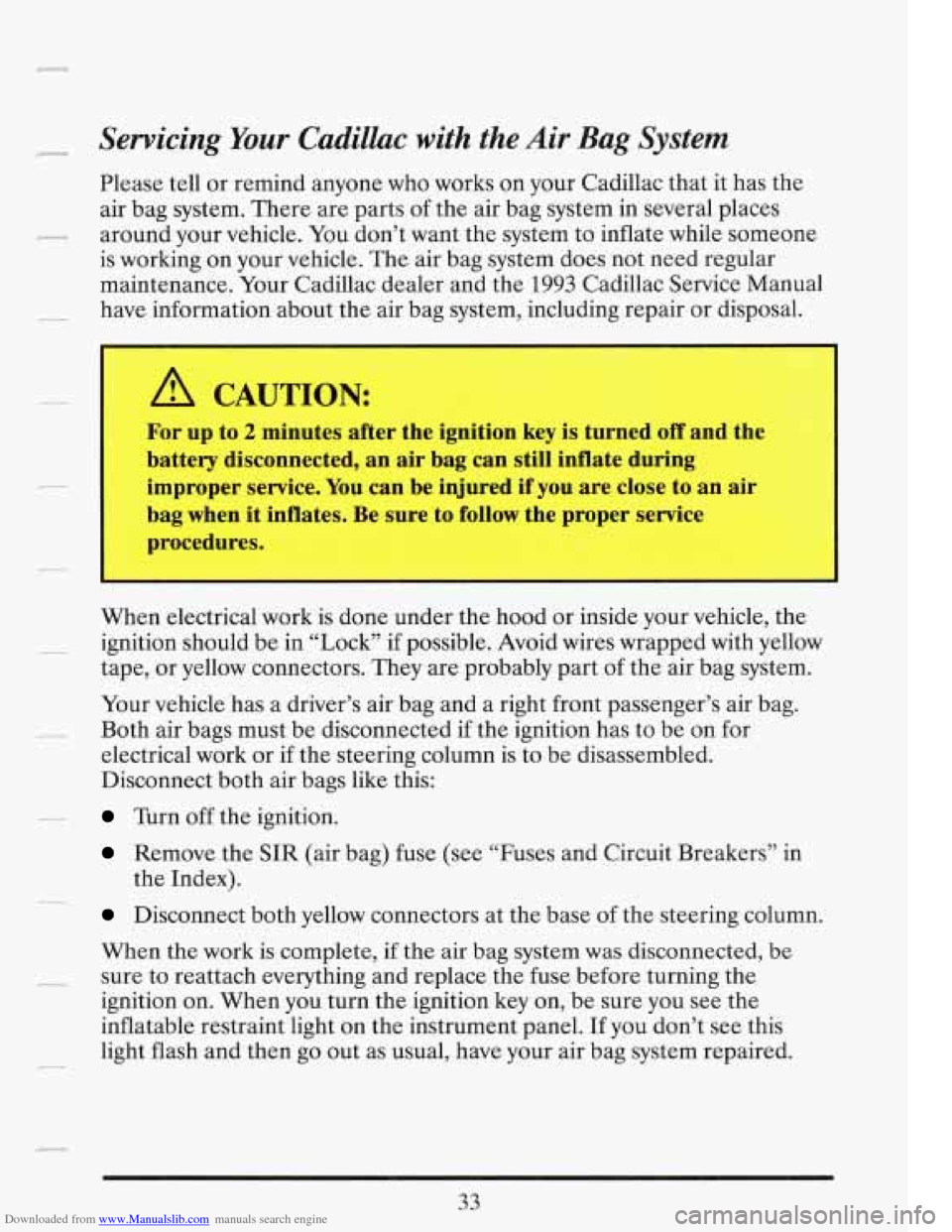
Downloaded from www.Manualslib.com manuals search engine Servicing Your Cadillac with the Air Bag System
Please tell or remind anyone who works on your Cadillac that it has the
air bag system. There are parts of the air bag system in several places
around your vehicle. You don’t want the system to inflate while someone
is working on your vehicle. The air bag system does not need regular
maintenance. Your Cadillac dealer and the
1993 Cadillac Service Manual
have information about the air bag system, including repair or disposal.
I
I
A CAUTION: I
I For up to 2 minutes after the ignition key is turned off and the
battery disconnected, an air bag can still inflate during
improper service. You can be injured if you are close to an air
bag when it inflates. Be sure to follow the proper service
procedures.
I
When electrical work is done under the hood or inside your vehicle, the
ignition should be in “Lock”
if possible. Avoid wires wrapped with yellow
tape, or yellow connectors. They are probably part of the air bag system.
Your vehicle has a driver’s air bag and a right front passenger’s air bag.
Both air bags must be disconnected
if the ignition has to be on for
electrical work or if the steering column is to be disassembled.
Disconnect both air bags like this:
Turn off the ignition.
Remove the SIR (air bag) fuse (see “Fuses and Circuit Breakers” in
Disconnect both yellow connectors at the base of the steering column.
the
Index).
When the work
is complete, if the air bag system was disconnected, be
sure to reattach everything and replace the fuse before turning the
ignition
on. When you turn the ignition key on, be sure you see the
inflatable restraint light on the instrument panel. If you don’t see this
light flash and then go out as usual, have your air bag system repaired.
33
Page 173 of 386
Downloaded from www.Manualslib.com manuals search engine zone, or some other potentially dangerous situation. Likewise, a yellow
solid line painted on the road means “Don’t Cross.”
LOW
SHOULDER
Y
WORKERS
AHEAD FLAGGER
AHEAD
ORANGE indicates road construction or maintenance. You’ll want to
slow down when you see an orange sign, as part
of the road may be closed
off or torn up. And there may be workers and maintenance vehicles
around, too.
WEST 1
GREEN is used to guide the driver. Green signs may indicate upcoming
freeway exits
or show the direction you should turn to reach a particular
place.
159
Page 229 of 386
Downloaded from www.Manualslib.com manuals search engine - Maintenance when Trailer Towing
Your vehicle will need service more often when you’re pulling a trailer.
See the Maintenance Schedule for more on this. Things that are
(don’t overfill), engine oil, axle lubricant, belt, cooling system, and brake
adjustment. Each
of these is covered in this manual, and the Index will
__- help you find them quickly. If you’re trailering, it’s a good idea to review
these sections before you start your trip.
Check periodically to see that all hitch nuts and bolts are tight.
rc-.- especially important in trailer operation are automatic transmission fluid
215
Page 265 of 386
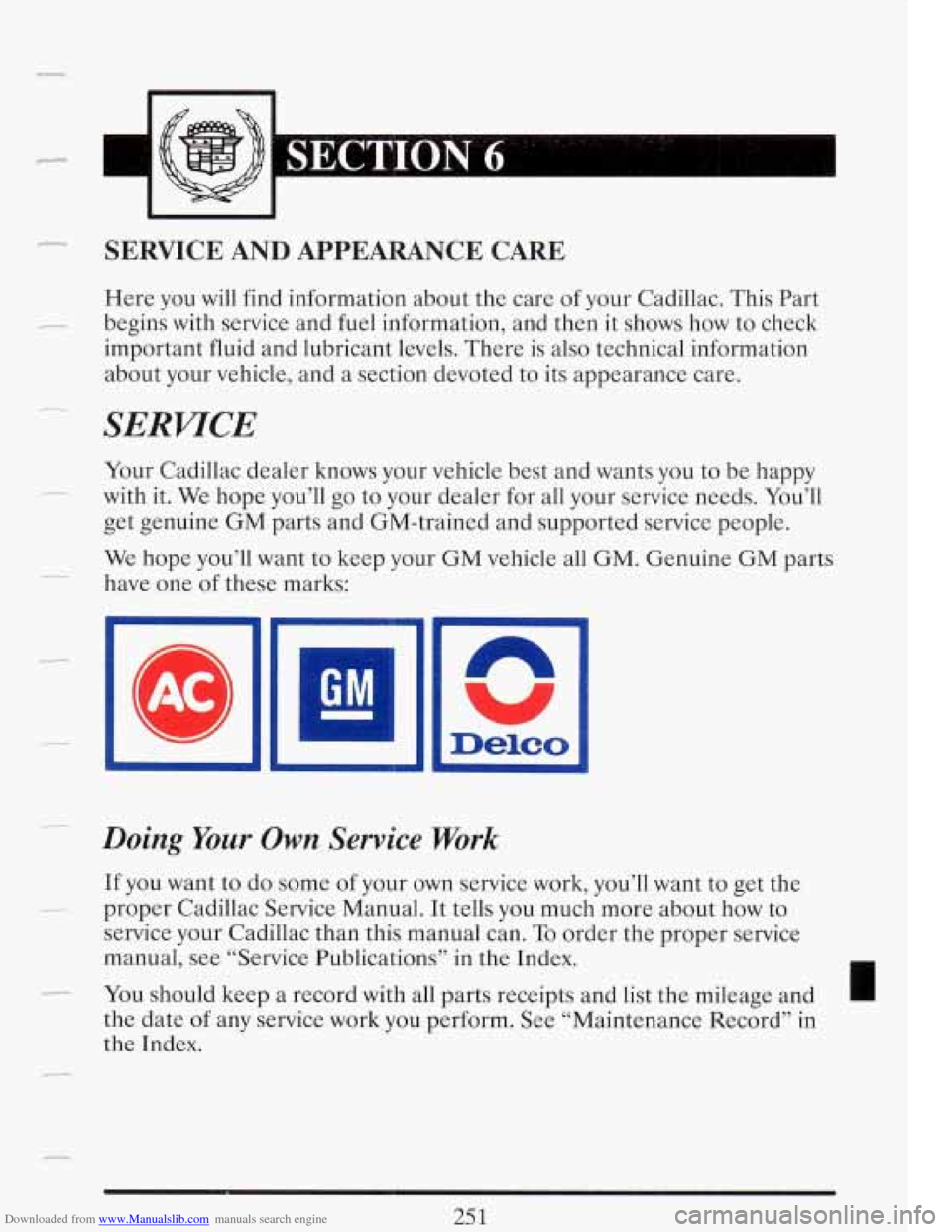
Downloaded from www.Manualslib.com manuals search engine r
SERVICE AND APPEARANCE CARE
Here you will find information about the care of your Cadillac. This Part
begins with service and fuel information, and then it shows how to check
important fluid and lubricant levels. There is also technical information
about your vehicle, and a section devoted to its appearance care.
SERWCE
Your Cadillac dealer knows your vehicle best and wants you to be happy
with it. We hope you’ll go to your dealer for all your service needs. You’ll
get genuine GM parts and GM-trained and supported service people.
We hope you’ll want to keep your GM vehicle all GM. Genuine GM parts
have one of these marks:
w wu
A
Doing Your Own Service Work
If you want to do some of your own service work, you’ll want to get the
service your Cadillac than this manual can.
To order the proper service
manual, see “Service Publications” in the Index.
- proper Cadillac Service Manual. It tells you much more about how to
,- You should keep a record with all parts receipts and list the mileage and I
the date of any service work you perform. See “Maintenance Record” in
the Index.
25 1
Page 266 of 386
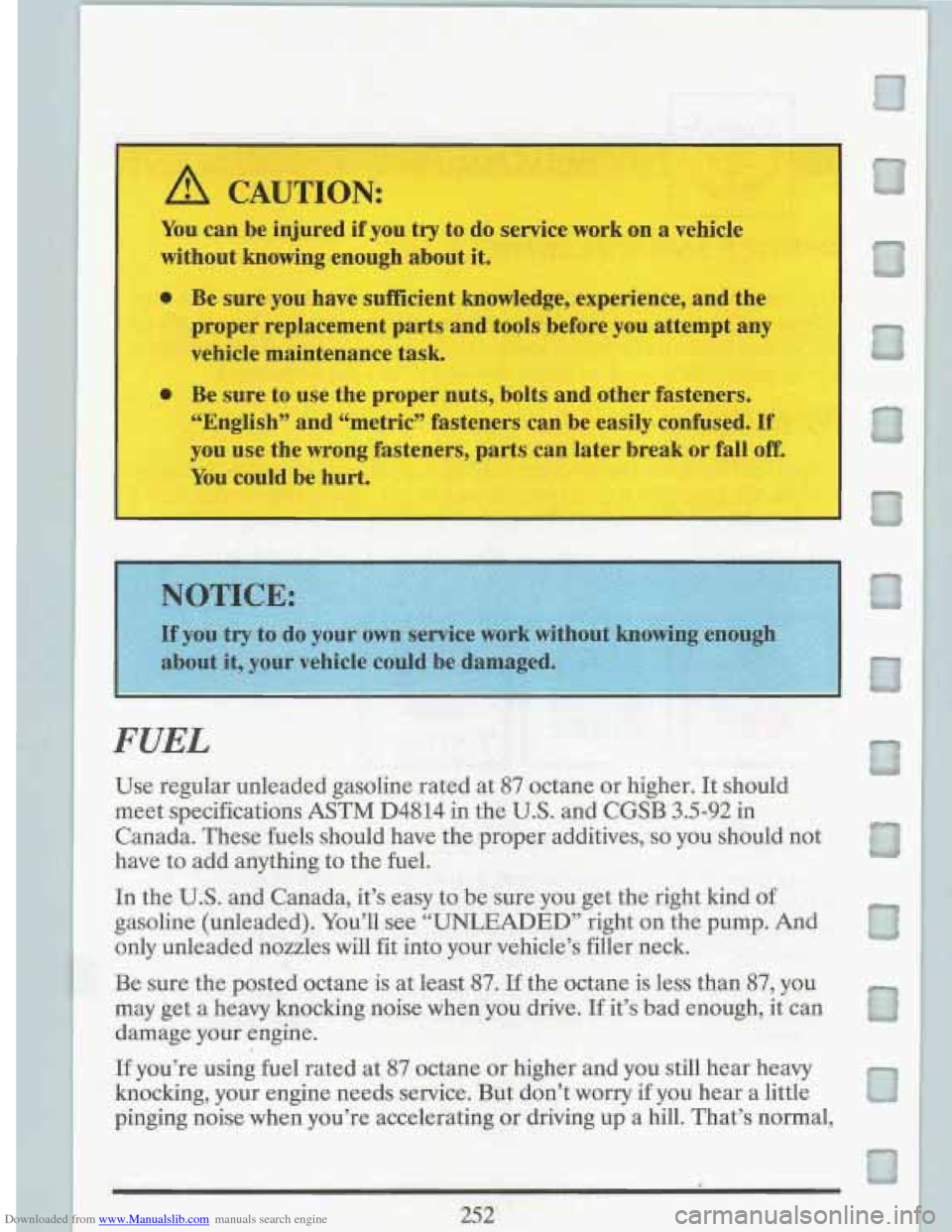
Downloaded from www.Manualslib.com manuals search engine A CAUTION:
You can be injured if you try to do service work on a vehicle
without knowing enough about it.
0 Be sure you have sufficient knowledge, experience, and the
proper replacement parts and tools before you attempt any
vehicle maintenance task.
0 Be sure to use the proper nuts, bolts and other fasteners.
“English” and “metric” fasteners can be easily confused.
If
you use the wrong fasteners, parts can later break or fall off.
You could be hurt.
1DOUt
FUEL
Use regular unleaded gasoline rated at 87 octane or higher. It should
meet specifications
ASTM D4814 in the U.S. and CGSB 3.5-92 in
Canada. These fuels should have the proper additives,
so you should not
have to add anything to the fuel.
1 the U.S. and Canada, it’s easy to be sure you get the right kind of
gasoline (unleaded). You’ll see
“UNLEADED” right on the pump. And
only unleaded nozzles will fit into your vehicle’s filler neck.
Be sure the posted octane is at least
87. If the octane is less than 87, you
may get a heavy knocking noise when you drive. If it’s bad enough, it can
damage your engine.
If you’re using fuel rated at
87 octane or higher and you still hear heavy
knocking, your engine needs service. But don’t worry if you hear a little
pinging noise when you’re accelerating
or driving up a hill. That’s normal,
Page 279 of 386
Downloaded from www.Manualslib.com manuals search engine AIR CLEAlVER
Refer to the
Maintenance Schedule
to determine when to
replace the air filter.
.- See “Scheduled Maintenance Services” in the Index.
c- A CAUTION:
Operating the engine with the air cleaner off can cause you or
others to be burned. The
air cleaner not only cleans the air, it
engine backfires, you could be burned. Don’t drive with it off,
and be careful working on the engine with the air cleaner
off.
~ stops flame if the engine backfires. If it isn’t there, and the
265
Page 280 of 386
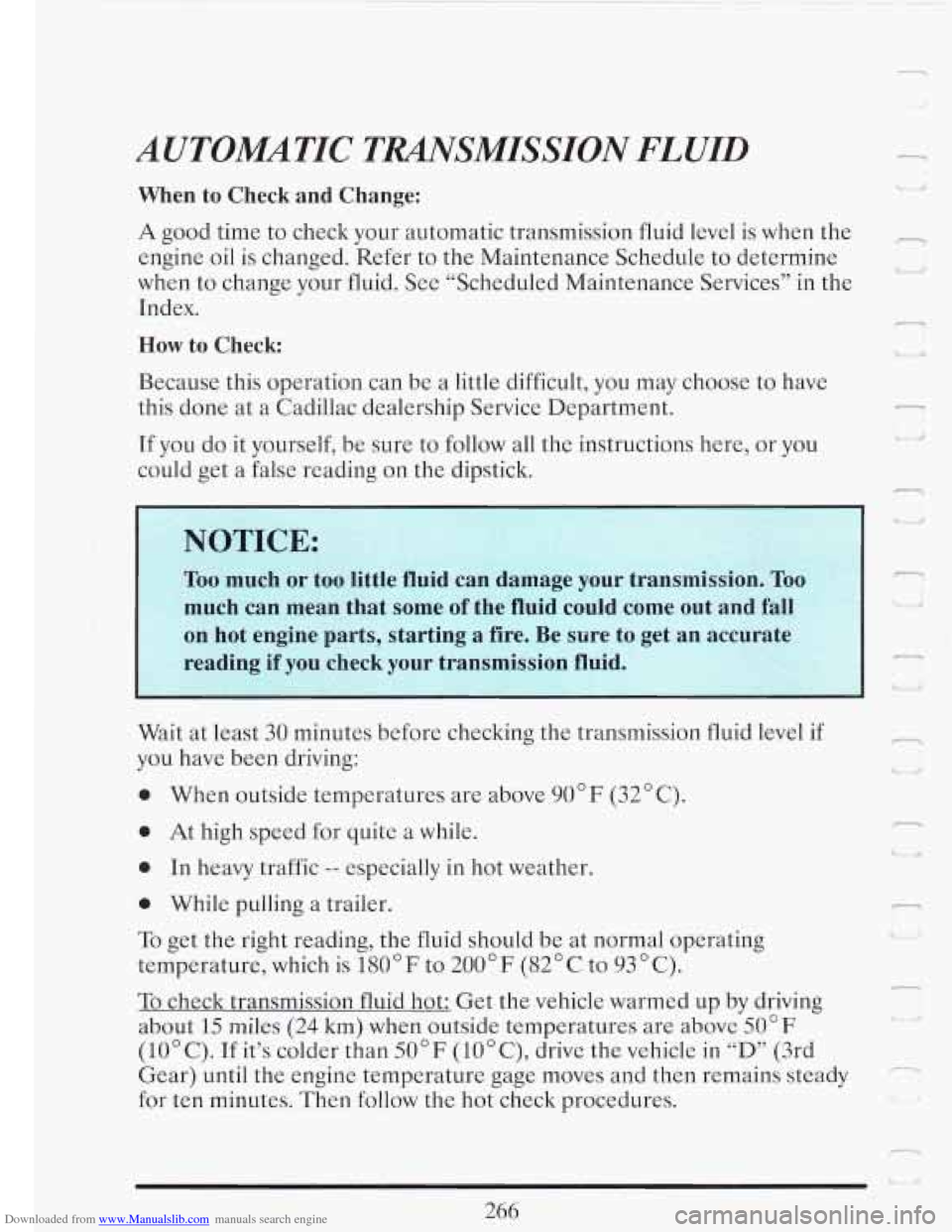
Downloaded from www.Manualslib.com manuals search engine AUTOMATIC TMSMISSION FLUID
When to Check and Change:
A good time to check your automatic transmission fluid level is when the
engine oil is changed. Refer to the Maintenance Schedule to determine
cpr
when to change your fluid. See “Scheduled Maintenance Services’’ in the
Index. -I
How to Check
BeC’%’uSe this operation can be a little difficult, you may choose to have
this done at a Cadillac dealership Service Department.
r IYI
”I If you do it yourself, be sure to follow all the instructions here, or you
could get a false reading on the dipstick.
p_
NOTICE:
I
Too much or too little fluid can damage your transmission.
much can mean that some of the fluid could come out and fall
on hot engine parts, starting
a fire. Be sure to get an accurate
reading if you check
your transmission fluid. I
l-
Wait at least 30 minutes before checking the transmission fluid level if
you have been driving:
0 When outside temperatures are above 90” F (32” C).
n !‘ b
0 At high speed for quite a while.
0 In heavy traffic -- especially in hot weather.
0 While pulling a trailer.
To get the right reading, the fluid should be at normal operating
temperature, which is
180°F to 200°F (82°C to 93OC).
To check transmission fluid hot: Get the vehicle warmed up by driving
about
15 miles (24 km) when outside temperatures are above 50°F
(10°C). If it’s colder than 50°F (lO°C), drive the vehicle in “D” (3rd
Gear) until the engine temperature gage moves and then remains steady
-
for ten minutes. Then follow the hot check procedures. t3
_L-
1 <- 1
266
Page 282 of 386
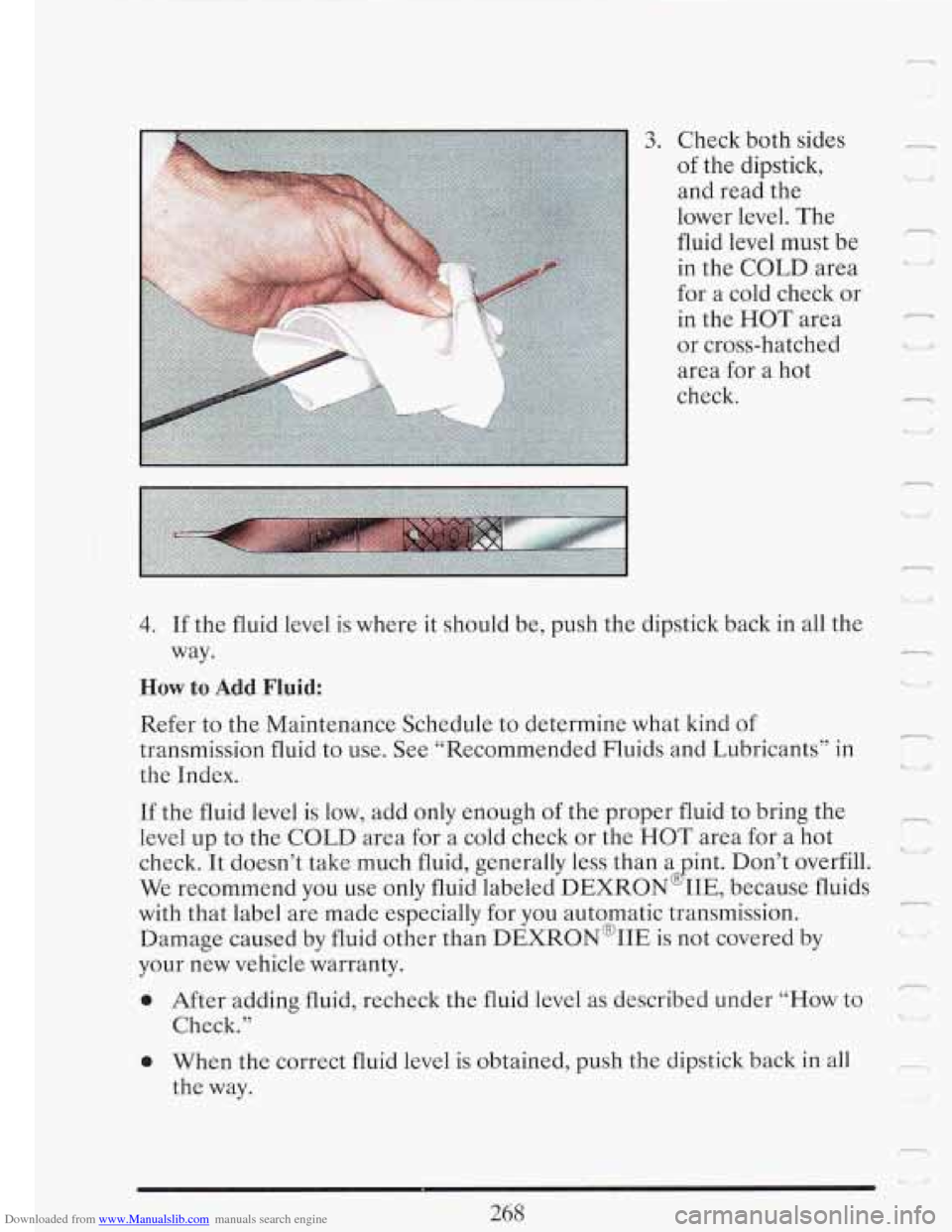
Downloaded from www.Manualslib.com manuals search engine 3. Check both sides
of the dipstick,
and read the
lower level. The
fluid level must be
in the COLD area
for a cold check or
in the HOT area
or cross-hatched area for a hot
check.
r
i4
I’
n i; U
4. If the fluid level is where it should be, push the dipstick back in all the
way.
How to Add Fluid:
Refer to the Maintenance Schedule to determine what kind of
transmission fluid to use. See “Recommended Fluids and Lubricants” in
the Index.
If the fluid level is low, add only enough of the proper fluid to bring the
level
up to the COLD area for a cold check or the HOT area for a hot
check. It doesn’t take much fluid, generally less than a
int. Don’t overfill.
We recommend you use only fluid labeled
DEXRON IIE, because fluids
with that label are made especially for you automatic transmission.
Damage caused
by fluid other than DEXRON@IIE is not covered by
your new vehicle warranty.
8
0 After adding fluid, recheck the fluid level as described under “How to
Check.”
0 When the correct fluid level is obtained, push the dipstick back in all
the way.
n I L> Y
r
Ll
I
r.
- I ‘1